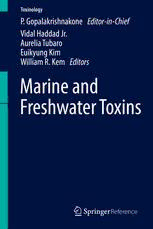
Marine and Freshwater Toxins PDF
Preview Marine and Freshwater Toxins
Toxinology P. Gopalakrishnakone Editor-in-Chief Vidal Haddad Jr. Aurelia Tubaro Euikyung Kim William R. Kem Editors Marine and Freshwater Toxins 1 3 Reference Toxinology Editor-in-Chief P.Gopalakrishnakone Inrecentyears,thefieldoftoxinologyhasexpandedsubstantially.Ontheonehand it studies venomous animals, plants and micro organisms in detail to understand their mode of action on targets. While on the other, it explores the biochemical composition, genomics and proteomics of toxins and venoms to understand their threeinteractionwithlifeforms(especiallyhumans),developmentofantidotesand exploringtheirpharmacologicalpotential.Therefore,toxinologyhasdeeplinkages with biochemistry, molecular biology, anatomy and pharmacology. In addition, there is a fast-developing applied subfield, clinical toxinology, which deals with understanding and managing medical effects of toxins on human body. Given the huge impact of toxin-based deaths globally, and the potential of venom in gener- ation of drugs for so-far incurable diseases (for example, diabetes, chronic pain), the continued research and growth of the field is imminent. This has led to the growth of research in the area and the consequent scholarly output by way of publications in journals and books. Despite this ever-growing body of literature within biomedical sciences, there is still no all-inclusive reference work available that collects all of the important biochemical, biomedical and clinical insights relatingtotoxinology. Composed of 12 volumes, Toxinology provides comprehensive and authoritative coverage of the main areas in toxinology, from fundamental concepts to new developmentsandapplicationsinthefield.Each volumecomprisesafocusedand carefullychosencollectionofcontributionsfromleadingnamesinthesubject. SeriesTitles 1.BiologicalToxinsandBioterrorism 2.ClinicalToxinologyintheAsiaPacificandAfrica 3.SpiderVenoms 4.ScorpionVenoms 5.MarineandFreshwaterToxins 6.VenomGenomicsandProteomics 7.SnakeVenoms 8.EvolutionofVenomousAnimalsandTheirVenoms 9.MicrobialToxins 10.PlantToxins 11.ToxinsandDrugDiscovery 12.ClinicalToxinologyinAustralia,Europe,andAmericas Moreinformationaboutthisseriesathttp://www.springer.com/series/13330 P. Gopalakrishnakone Editor-in-Chief Vidal Haddad Jr. (cid:129) Aurelia Tubaro Euikyung Kim (cid:129) William R. Kem Editors Marine and Freshwater Toxins With121Figuresand23Tables Editor-in-Chief P.Gopalakrishnakone VenomandToxinResearchProgramme DepartmentofAnatomy YongLooLinSchoolofMedicine NationalUniversityofSingapore Singapore Editors VidalHaddadJr. AureliaTubaro BotucatuMedicineSchool DepartmentofLifeSciences UniversidadeEstadualPaulista UniversityofTrieste Botucatu,Sa˜oPaulo,Brazil Trieste,Italy EuikyungKim WilliamR.Kem LaboratoryofPharmacologyand DepartmentofPharmacologyand Toxicology,CollegeofVeterinaryMedicine Therapeutics,CollegeofMedicine GyeongsangNationalUniversity UniversityofFlorida Jinju,SouthKorea Gainesville,FL,USA ISBN978-94-007-6418-7 ISBN978-94-007-6419-4(eBook) ISBN978-94-007-6420-0(printandelectronicbundle) DOI10.1007/978-94-007-6419-4 LibraryofCongressControlNumber:2015958524 #SpringerScience+BusinessMediaDordrecht2016 Thisworkissubjecttocopyright.AllrightsarereservedbythePublisher,whetherthewholeorpartof the material is concerned, specifically the rights of translation, reprinting, reuse of illustrations, recitation,broadcasting,reproductiononmicrofilmsorinanyotherphysicalway,andtransmissionor informationstorageandretrieval,electronicadaptation,computersoftware,orbysimilarordissimilar methodologynowknownorhereafterdeveloped. The use of general descriptive names, registered names, trademarks, service marks, etc. in this publicationdoesnotimply,evenintheabsenceofaspecificstatement,thatsuchnamesareexempt fromtherelevantprotectivelawsandregulationsandthereforefreeforgeneraluse. Thepublisher,theauthorsandtheeditorsaresafetoassumethattheadviceandinformationinthisbook arebelievedtobetrueandaccurateatthedateofpublication.Neitherthepublishernortheauthorsorthe editorsgiveawarranty,expressorimplied,withrespecttothematerialcontainedhereinorforanyerrors oromissionsthatmayhavebeenmade. Printedonacid-freepaper ThisSpringerimprintispublishedbySpringerNature TheregisteredcompanyisSpringerScience+BusinessMediaB.V.Dordrecht. Series Preface The term TOXIN is derived from the Greek word Toeikov and is defined as a substance derived from tissues of a plant, animal, or microorganism that has a deleterious effect on other living organisms. Studying their detailed structure, function,andmechanismofactionaswellasfindinganantidotetothesetoxinsis thefieldofTOXINOLOGY,andthescientistsarecalledTOXINOLOGISTS. In recent years, the field of toxinology has expanded substantially. On the one hand, it studies venomous animals, plants, and microorganisms in detail to understand their habitat, distribution, identification, as well as mode of action on targets,whileontheother,itexploresthebiochemicalcomposition,genomics,and proteomics of toxins and venoms to understand their interaction with life forms (especially humans), the development of antidotes, and their pharmacological potential for drug discovery. Therefore, toxinology has deep linkages with biochemistry, molecular biology, anatomy, pharmacology, etc. In addition, there is a fastdeveloping applied subfield, clinical toxinology, which deals with understanding and managing medical effects of venoms and toxins on the human body following envenomations. Given the huge impact of envenomation-based deaths globally and the potential of venom in the generation of drugs for debilitating diseases (e.g., diabetes, chronic pain, and cancer), the continued researchandgrowthofthefieldisimminent. Springer has taken the bold initiative of producing this series, which is not an easy target of producing about 12 volumes, namely, biological toxins and bioterrorism,clinicaltoxinology,scorpionvenoms,spidervenoms,snakevenoms, marine and freshwater toxins, toxins and drug discovery, venom genomics and proteomics, evolution of venomous animals and their toxins, plant toxins, and microbialtoxins. Singapore P.Gopalakrishnakone MBBS,PhD,FAMS,DSC Editor-in-Chief v Acknowledgments Iwouldliketosincerelythankthesectioneditorsofthisvolume,VidalHaddadJr., AureliaTubaro,EuikyungKim,andWilliamR.Kem,fortheinvaluablecontribu- tion of their expertise and time and the authors who obliged with my request and providedacomprehensivereviewonthetopics. Springer provided substantial technical and administrative help by many indi- vidualsatvaryinglevels,butspecialmentionshouldgototheSpringereditorsfor theirtirelesseffortinbringingthesevolumestoreality. Singapore P.Gopalakrishnakone MBBS,PhD,FAMS,DSC Editor-in-Chief vii Volume Preface Marine and freshwater organisms, ranging from cyanobacteria, dinoflagellates to diatoms, can produce structurally different secondary metabolites that can pose threats to human health and to other aquatic forms of life but also have negative economic impacts on aquaculture, mariculture, and/or tourism industry. These toxinscanbealsoaccumulatedandbiotransformedinvectoranimals(invertebrates and fish) leading to more complex toxic threat. Marine toxins are responsible for avian poisonings, massive fish kills, birth morbidity and mortality, and sanitary, ecological,andeconomicproblems.Poisoningsofhumansandotheranimalsresult fromconsumptionofcontaminatedfood,mainlyshellfish,duetotheirfilterfeeding on toxic algae, which are the target of the most extensive monitoring efforts. Anyway, other exposure routes, such as inhalational and cutaneous exposures to specific toxins, can lead to significant adverse effects. Concerning the specific mechanismofaction,manyofthetoxinspresentlimitationsandchallengesinthe toxicologicalstudiesandintheirmanagementduetotheverylimitedavailabilityof purified toxins and certified reference materials for toxicological studies. In fact, manytoxinsarenotcommerciallyavailableandmanyofthetoxicologicalstudies werecarriedoutusingareducednumberofanimals,sometimesbyparenteralroute of administration, to maximize the toxicological effects, rather than after oral administration,theusualexposureroute. Marineandfreshwaterenvironmentsarethenewfrontiersofhumanity,butthe increase of economic and touristic activities provokes nasty encounters between aquatic animals and humans. The main victims are swimmers, professional and sportive fishermen, surfers, and scuba divers as well as people working in related fields. The identification, knowledge, and treatment of envenomations caused by venomous and poisonous animals are not adequate and the prevention of injuries still is not possible. Additionally, the immense potential of the pharmacologic effects of their toxins is not fully explored. Toxins of venomous aquatic animals cancauseproteolysis,myotoxicity,hemotoxicity(mainlyhemolysis),cytotoxicity, andneurotoxicity.Theneurotoxicityisgenerallyassociatedwithtoxinsofdinofla- gellatesandcyanobacteriapresentinpoisonousand/orcontaminatedinvertebrates andfish. Thisvolumeintendstopresentthestructureofthemaintoxinsofaquaticorigin, theirdistribution,producingspeciesandvectors,themechanismofaction,andthe ix
